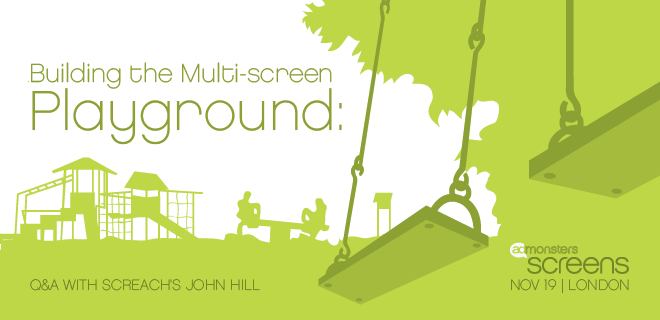
So, tell me this isn’t really cool:
I can totally see myself spending hours playing this game in public, frantically jerking my smartphone to become a master racecar driver. I can imagine the security guards having to drag me out as the mall closed but I refused to quit playing because I was this close to getting a level up. I can see myself being arraigned at a courthouse after I was caught breaking and entering on the premisis for one last shot at the title.
This is what Screach does: drive young men to lawbreaking and insanity. NO, no, I mean the company delivers multiscreen engagements wherever media can be displayed (check out more examples here), whether that’s a mall, a football stadium, you name it. And the above is really only the start of what’s possible with platforms like Screach – At AdMonsters Screens, Nov. 19 in London, Founder and CEO Paul Rawlings plus Platform Advocate John Hill will dive into the technology that brings multi-screen engagement to life and the opportunities for publishers and advertisers willing to take the leap.
For a preview of their session, we caught up with Hill to hear about the latest version of Screach, the perks and challenges of working with brands, and whether the QR code is actually a viable marketing tool.
On September 19, you guys announced a major revamp for the Screach app – what are the biggest changes and new features? Are there any advertising developments to speak of? How do you feel it furthers the vision of a multiscreen playground?
The recent adaptation of the Screach platform is all about making it easier for people to create their own experiences, and for people to discover new ones. As the company has developed, we’ve increasingly seen the benefits of people being free to use their imaginations to do amazing things with the technology. This means you’ll see creative people making this technology work for brands in their own industries, whether that’s radio, TV, digital out of home, pubs, museums or even stadiums.
If we’re going to realise the vision of having a “multiscreen playground,” as you say, it’s not something that a few companies are going to be able to build just by themselves. Sure, the technology might come from a few, but it’s only going to happen if we allow people with different experiences the tools to create the things they know their industries need.
Our platform allows customers to focus on delivering engaging experiences, and that drives advertising. Advertising is more effective when people are actually engaging with your experience, and not as brutally aware that they’re being advertised to. There’s also the potential to build a picture of what they want to see from all the other experiences they’re tapping into.
What are the biggest challenges of working with brands in building sponsored multiscreen experiences?
One of the things that’s driven us since the very beginning has been the innovation we’ve seen from people who’ve got their hands on the platform. When we talk about what Screach can do, they come straight back with fantastic uses we haven’t thought of before. That’s very encouraging for the future, when you see real appetite and imagination out there. There will be some really cool interactive experiences around in the next few years, some in places you don’t expect.
However, it’s easy to forget a lot of this is still very new. So one big challenge is designing and creating experiences that actually make your audience want to interact with the campaign. In the past, you’d put an ad out there and you’d only have a rough idea of how it was received. Now you can get more exact figures back on engagement and reaction, it really forces you to re-assess what you think works. Sometimes that means letting go of some approaches you’ve relied on for years. It’s a real balance, creating something that gets the message out there but can also get someone to stop for a little while and interact.
How do you measure the success of a campaign like Cadbury’s, or really how do you explain the results to the CMO? Is there a demand for ROI?
How do you actually measure the impact of a campaign these days? For years, metrics have been regarded as an important indicator of a campaign’s success, but many of them offer very little information about who’s truly engaging. The benefit of the Screach platform to businesses is that it gives brands an accurate idea of exactly how people have engaged with the campaign, and the interactivity of the experience means you’ve got their attention in a more meaningful way.
Companies aren’t up for throwing their money into a black hole, so there’s certainly a demand for some return on their investment, even if it’s not necessarily financial. However, if you can give brands a way to pinpoint and start to talk to those potential customers; those people who are really interested and engaged rather than just bystanders, that’s definitely worth its weight in gold for a company looking to make meaningful connections.
How did you guys get involved with the Pepsico10 startup incubator program? What have been some of the perks?
From the offset, Screach has worked with major brands such as Bauer, Channel 4, Microsoft, Universal and Fox. Pepsico is a really innovative brand, and we wanted to be able to show them how our platform could help them drive their innovation further. We’re working with them as we speak to help them re-fresh their marketing.
Brands are our customers so it’s important that we have really close relationships with them. It’s great that brands are out there looking for ways to innovate, and to support the people that provide that innovation. But as ever, when it comes to taking on funding and support, it all comes down to a company decision on how you want to work with clients and develop your business.
So QR codes from an advertiser’s perspective – awesome or waste of time? How much longer are they for this world?
QR codes are a tool. So whether they’re awesome or a waste of time is entirely down to how you use them. Have you seen the site http://wtfqrcodes.com/? Does the world need a QR code on a website’s contacts page that leads the user to the same page? Of course it doesn’t. But there are several areas in which QR codes work well. As with anything, it’s less about “how can you use QR codes in your business?” than “have you got a problem that be solved by QR codes?”.
QR codes are definitely a step in the right direction. Brands and businesses are looking to engage with their customers, and so QR codes are a good way to start. We use them. But, equally, there are other methods brands can use to launch interactions with customers, such as numerical codes and audio recognition when you’re watching TV. It’s about starting a conversation with the customer as soon as possible, and a QR code is just one way to do that.
For example, you’ve now got the ability to play a video just by hovering over a certain image. And with ScreachTV, you can turn any pub or venue TV into an interactive screen, giving people the chance to play games, post messages or experience relevant, local content using their smartphones. The great thing about this is that it gives the venue or organisation a chance to see who’s interacting with them, and give them more of what they really enjoy. It’s much more of a conversation, rather than just a new way to shout at people.
 |
The age of multi-screen is upon us. Whether you’re interested in mobile, tablet, IPTV, goggles, or other enabled devices, learn cutting edge techniques and best practices from industry leaders and get involved in discussions with expert panelists only at AdMonsters Screens, Nov. 19 in London. |